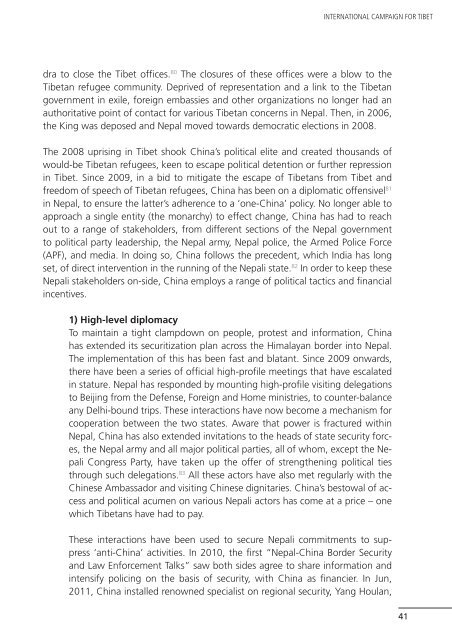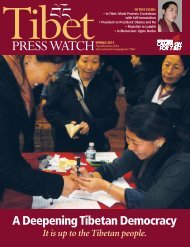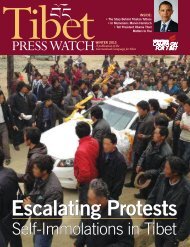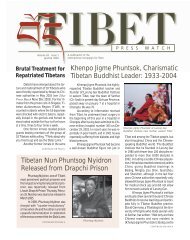DANGEROUS CROSSING: - International Campaign for Tibet
DANGEROUS CROSSING: - International Campaign for Tibet
DANGEROUS CROSSING: - International Campaign for Tibet
Create successful ePaper yourself
Turn your PDF publications into a flip-book with our unique Google optimized e-Paper software.
INTERNATIONAL CAMPAIGN FOR TIBET<br />
dra to close the <strong>Tibet</strong> offices. 80 The closures of these offices were a blow to the<br />
<strong>Tibet</strong>an refugee community. Deprived of representation and a link to the <strong>Tibet</strong>an<br />
government in exile, <strong>for</strong>eign embassies and other organizations no longer had an<br />
authoritative point of contact <strong>for</strong> various <strong>Tibet</strong>an concerns in Nepal. Then, in 2006,<br />
the King was deposed and Nepal moved towards democratic elections in 2008.<br />
The 2008 uprising in <strong>Tibet</strong> shook China’s political elite and created thousands of<br />
would-be <strong>Tibet</strong>an refugees, keen to escape political detention or further repression<br />
in <strong>Tibet</strong>. Since 2009, in a bid to mitigate the escape of <strong>Tibet</strong>ans from <strong>Tibet</strong> and<br />
freedom of speech of <strong>Tibet</strong>an refugees, China has been on a diplomatic offensivel 81<br />
in Nepal, to ensure the latter’s adherence to a ‘one-China’ policy. No longer able to<br />
approach a single entity (the monarchy) to effect change, China has had to reach<br />
out to a range of stakeholders, from different sections of the Nepal government<br />
to political party leadership, the Nepal army, Nepal police, the Armed Police Force<br />
(APF), and media. In doing so, China follows the precedent, which India has long<br />
set, of direct intervention in the running of the Nepali state. 82 In order to keep these<br />
Nepali stakeholders on-side, China employs a range of political tactics and financial<br />
incentives.<br />
1) High-level diplomacy<br />
To maintain a tight clampdown on people, protest and in<strong>for</strong>mation, China<br />
has extended its securitization plan across the Himalayan border into Nepal.<br />
The implementation of this has been fast and blatant. Since 2009 onwards,<br />
there have been a series of official high-profile meetings that have escalated<br />
in stature. Nepal has responded by mounting high-profile visiting delegations<br />
to Beijing from the Defense, Foreign and Home ministries, to counter-balance<br />
any Delhi-bound trips. These interactions have now become a mechanism <strong>for</strong><br />
cooperation between the two states. Aware that power is fractured within<br />
Nepal, China has also extended invitations to the heads of state security <strong>for</strong>c-<br />
es, the Nepal army and all major political parties, all of whom, except the Nepali<br />
Congress Party, have taken up the offer of strengthening political ties<br />
through such delegations. 83 All these actors have also met regularly with the<br />
Chinese Ambassador and visiting Chinese dignitaries. China’s bestowal of ac-<br />
cess and political acumen on various Nepali actors has come at a price – one<br />
which <strong>Tibet</strong>ans have had to pay.<br />
These interactions have been used to secure Nepali commitments to sup-<br />
press ‘anti-China’ activities. In 2010, the first “Nepal-China Border Security<br />
and Law En<strong>for</strong>cement Talks” saw both sides agree to share in<strong>for</strong>mation and<br />
intensify policing on the basis of security, with China as financier. In Jun,<br />
2011, China installed renowned specialist on regional security, Yang Houlan,<br />
41











